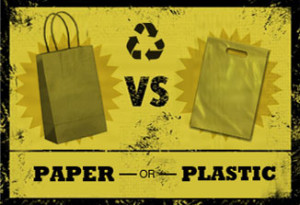
The historical “Gold Standard” for meeting environmental goals are “Reduce – Reuse – Recycle”. When retail packaging attempts to abide by these “rules”, there are numerous complications that must be weighed in a real environmental context.
For example, plastic bags are technically recyclable – but there are multiple recycling classifications for plastics which need to be separated. Plastic with different codes can not be recycled together. If a bag has a handle with a different type of plastic (or any other material) from the base, the handle must be removed and recycled separately.
While recycling is a major component of the environmental standard triad, recycling rates of plastic bags are extremely low. Less than 3% of the billions of plastic bags manufactured worldwide each year get recycled.
While recycling is a major component of the environmental standard triad, recycling rates of plastic bags are extremely low. Only 1-3% of plastic bags get recycled when it is estimated that 500 billion to 1 trillion bags are used worldwide each year.
This is a result of a combination of complications, including – municipal waste collecting processes, unawareness of separation needs, and lack of proper recycling facilities.
Pro’s & Con’s of Paper and Plastic
Paper
Pro’s:
- Renewable resource.
- Easily recyclable.
- Easily degrades if it does end up in the ocean or at a landfill.
Con’s:
- Heavier, higher volume shipments increase carbon footprint for shipping.
- Production process of some papers uses thousands of gallons of water and bleach to clean the pulp.
- It takes more than four times as much energy to manufacture a paper bag as it does to manufacture a plastic bag.
Plastic
Pro’s:
- Durability – more reusable, resistant to moisture.
- Less weight and volume means smaller carbon footprint for shipping.
- It takes less energy to recycle a pound of plastic than it takes to recycle a pound of paper.
Con’s:
- Problematic to recycle – Only 1-3% of all plastic bags wind up recycled.
- Normal plastic does not degrade in landfills or the ocean.
- 10% of the plastic produced every year worldwide winds up in the ocean. 70% of which finds its way to the ocean floor, where it will likely never degrade.
- Uses non-renewable petroleum products.
The Truth, The Law and Public Perception
Environmental truths and morality could be argued from either side of the debate, as seen in the pro’s and con’s lists above.
Real life truths (local access to waste streams or reliability of the facts and statistics supporting or opposing either material) only add to the complexity of the “ECO Friendly Packaging” decision process.
Many municipalities, cities and some states also have laws that regulate and limit the use of either material. These additional guidelines vary significantly across locations. Adding yet another dimension to an already complicated situation.
Public perception of which is the more “Green” choice is certainly paper. As plastic has been vilified for many years and has much more strict laws in many locations.
What Should I Choose?
The unpredictability of both the real life and environmental truths mentioned makes the decision between paper or plastic seem tough. Modern Arts feels that public perception and the following three facts tip the scales in favor of paper being the better choice.
- Recycled In / Recycled Out – 40-80% Post Consumer Waste (PCW) papers are readily available for manufacturing bags. Finding a recycled plastic to start production with is not as easy and is more cost prohibitive. When a paper bag reaches the end of its life, it is almost always recycled.
- Paper comes from a renewable resource, plastic does not.
- Paper is degradable. If it ends up in the ocean or a landfill, it won’t be there for generations to come.